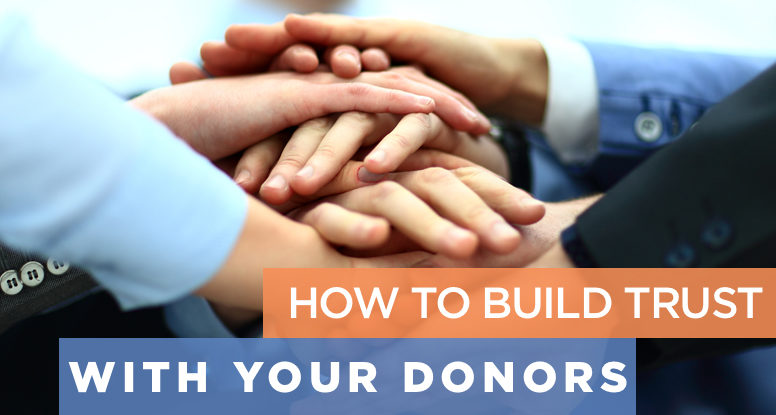
How to Build Trust with Your Donors
In today’s world, trust is something that is very hard to come by. Far too many “bad guys” are on the prowl to make a quick buck, often posing as legit non-profits. Some scammers focus on specific causes to play on a donor’s generosity. Others focus on emotional appeals or major disasters in the news.
Of course, their deceptive tactics are very frustrating to the many real organizations generating funds for real life-changing causes. When donors are taken for their hard-earned cash, they become very reluctant to donate again. They simply don’t want to get burned, and we can’t say that we blame them.
That’s why building, maintaining, and keeping the trust of your donors is an absolute must. After all, people only give to organizations that they are 100% confident in. Below, we explain how to maintain your organization’s credibility by putting honesty at the heart of your cause.
2. Develop transparency within the organization
You can’t expect to build trust if your non-profit maintains a level of secrecy. Be open to the community you serve. Don’t be afraid to publically share your non-profits:
- General operating budget
- How you spend the money
- Where do your contributions come from
- Who’s receiving the contributions
The more that your organization is able to be an “open book,” the more your potential donors will see that you have nothing to hide.
2. Have a professional website
You’ve probably heard the popular saying, “You can’t judge a book by its cover.” While that may be true, the reality is most people do. That includes websites. To help determine the legitimacy or your organization, a donor will likely check out your web page. When they do, they have a tendency to judge your non-profit by the “attractiveness” and design of your site. A site riddled with spelling errors or looks as if an amateur-built site isn’t very professional. If your website isn’t professional, donors are likely to assume the same about your organization. Take advantage of a website audit to learn how you can improve your site.
3. Make a lasting impression
We all know that first impressions are everything. From how you dress to how you talk and interact with the community—this all plays a huge role in credibility. As the face of your organization, your members should be professional at all times when interacting with the public. This means avoiding offensive language, questionable behavior, and inappropriate clothing. No donor is likely to donate money to an organization whose members reflect poorly on the cause they are supposed to represent.
4. Consider how even small actions can make a huge impact
Organization members should think about the very way they answer the phone, greet guests at their facility, create email signatures, etc. While small, every touch point should not be overlooked. Keep it all professional and classy. Also, train your volunteers accordingly. After all, they represent your organization. All of this consistency builds that trust.
5. Show your non-profit in action
When people donate to organizations, they want to see results. It’s simply proof that their hard-earned dollars are being put to good use. Don’t be afraid to share your organization’s success stories. Donors really do want to see them. For example, if your organization raised money to purchase holiday gifts for families in need, show your volunteers delivering the gifts and the families’ reactions. Share those photos/videos on your website and social media accounts. People always gravitate to these heart-warming images. Also, consider snapping photos or interviewing your volunteers, board members, or staff. This is just another great way to share stories from their point of view.
6. Tell personal stories
Go a step further and interview the people benefiting from the donations your non-profit receives. Share those interviews as well. It’s just another way to confirm that your organization is, in fact, making a real difference in the community. When donors are able to see “the evidence,” the more likely they are to give. We get that your organization may occasionally run into privacy issues, especially when dealing with children. However, there are ways to tell the story. Simply change the name of the person being interviewed or ask for permission. The same applies to photos.
7. Highlight a donor and what their contribution did
Don’t be afraid to feature a donor whose generous donation made a huge impact on the community. Highlighting a current donor is just another way for potential donors to see that “real people” are contributing to your nonprofit’s worthy cause. For those potential donors, it’s also reassuring.
8. Seek media coverage
For the most part, the general public still trusts what they see or read in the media. The next time your organization has a “newsworthy” cause or event taking place, don’t hesitate to reach out to your local media outlets. The coverage is not only a way to gain exposure, but it reassures potential donors that you are, in fact, the “real deal.”
How can we help you?
Do you need help reaching donors? If so, we can help. We are happy to offer a FREE, 30-minute consultation, just mention this post. In the meantime, leave a comment below or drop me a note at alizah@epsteincreative.com. I would love to hear from you!
